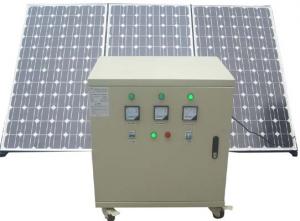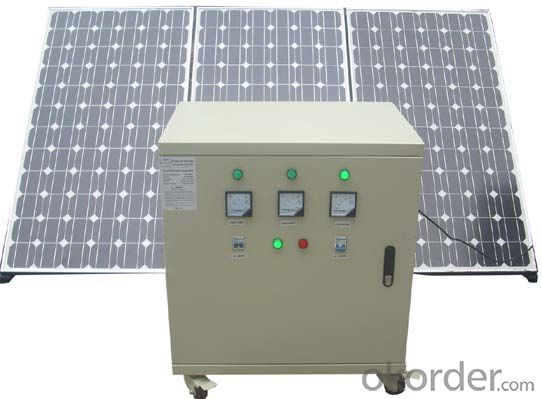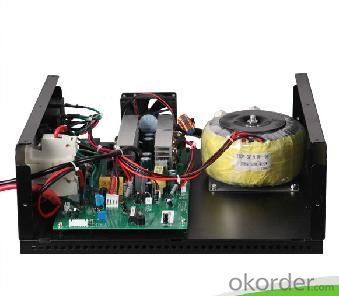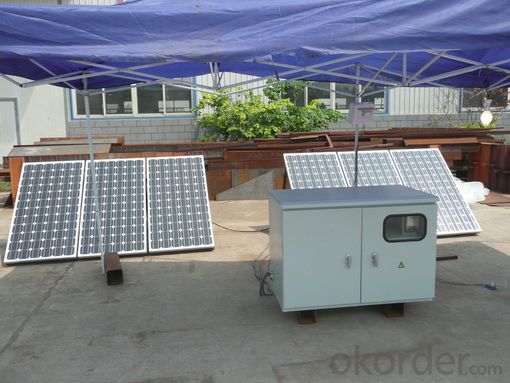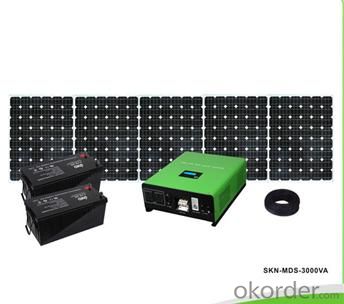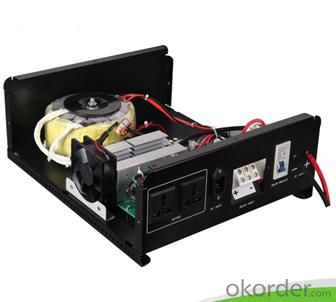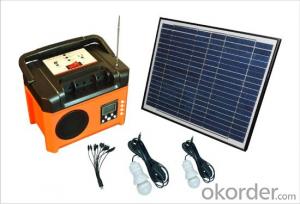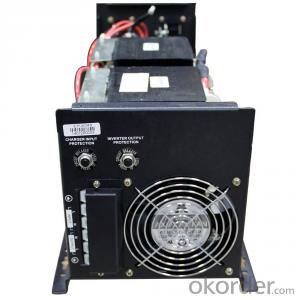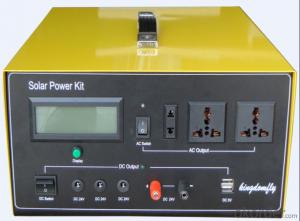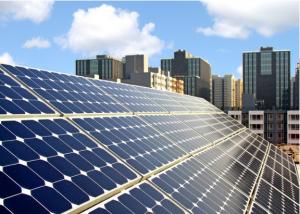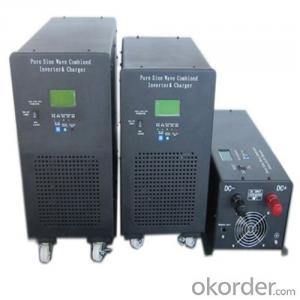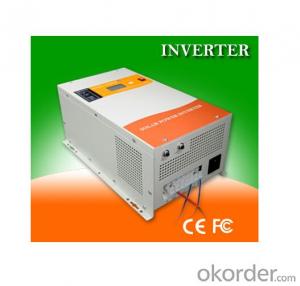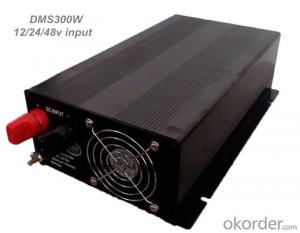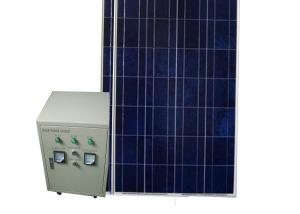Solar Energy Systems Keswick Pure Sine Wave Solar System SKN-MDS 1000VA-3000VA
- Loading Port:
- Shanghai
- Payment Terms:
- TT or LC
- Min Order Qty:
- 300 watt
- Supply Capability:
- 200000 watt/month
OKorder Service Pledge
OKorder Financial Service
You Might Also Like
Quick Details
| Specification: | Normal | Application: | Home | Output Voltage (V): | 110V or 220V |
| Load Power (W): | 800W-2400W | Solar Power (W): | 100W-3000W | Work Time (h): | as long as it works |
| Solar Panel: | Polycrystalline | Battery: | With Battry Together | form wave: | pure sine wave |
| transfer time: | less than 10ms | Inverter: | DC to AC | Solar Inverter: | Inverter With Controller Inside |
| DC: | 12V-48V | model: | from 1KVA-3KVA | pure sine wave: | yes |
| Packaging & Delivery | |
| Packaging Detail: | carton |
| Delivery Detail: | 1*20FT container within one month |
| Specifications | |
| inverter,controller building in one case | |
| pure sine wave inverter | |
| AC charger optional | |
| LED or LCD display | |
| 110V or 220V | |
Specifications
Pure Sine Wave Solar Inverter
>Solar Charge Controller Inside
>AC Charger Inside
>LED LCD Display
>Wall Mount Design CE ISO
Features:
1.Environmental protection
2.Energy-saving products
3.Portable
4.easily use
Advantages:
1.Safety and easy installation,Plug and play systems;
2.Good quality panel to ensure the high efficiency and long life needs;
3.Solar Automatic lighting controller :with adjustable run times, over-current protection;
4.Solar Batteries: Maintenance free, long life batteries
5.Lighting Source: LED lamp /Lantern (Fixed/Movable)
7.Flexible designs per client requests;
Using of scope:
It is very good for indoor use where there is shortage of electricity and for outdoor activities such as picnicking, fishing and camping. It is an ideal tool for Motor Mechanics, Farm House and small shop owners such as Hairdressers, Barbers, Cobblers, Tailors and Kiosk keepers.
Pure Sine Wave Solar Inverter SKN-MDS 1000VA To 3000VA For Home
1.Power Range: 1000VA 2000VA,3000VA
2.Power Factor: 0.8
3.DC Voltage: 12V,24V,48V
4.Include AC Charger Function Inside
5.The SKN-MDS Inverter Include Solar Charge Controller Inside
6.Pure Sine Wave Inverter SKN-MDS With AVR Function
7.Inverter With AC Charger With Solar Charge Controller With AVR All In One
8.22 Year Brand Quality Garantee
9.High End Inverter Design With Wall Mount Design
10.Popular Design With LED LCD Display
Pure Sine Wave Solar Inverter SKN-MDS Main Function Features
> Micro Processor Control
> Pure Sine Wave
> With AC Charger
> Intelligent Automatic Voltage Regulating Technology
> Intelligent Automatic Voltage Charging Technology
> Over Load, Short Circuit Protection
> Over Temperature Protection
> By Pass System
> Automatic Charge Even Inverter Is Off
> Shut Off Output By Manual If No Need Power
> Low Battery Protection
> Over Voltage, Low Voltage Protection
> With Polarity Protection
> Compatibility With Generators
> The LED&LCD Display Design Option
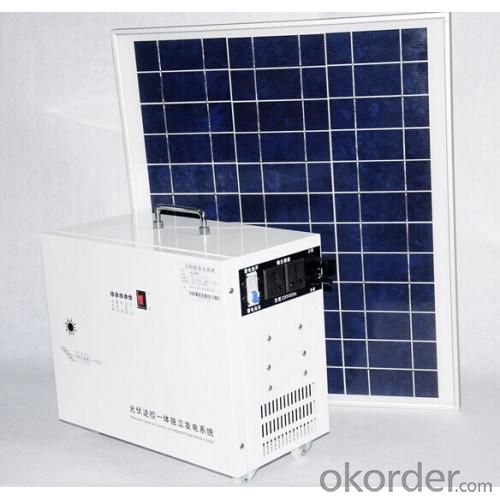
| SKN-MDS 800W SERIES TECHNICAL PARAMETER | |||
| SKN-MDS-3000-800W | |||
| Name Of Parts | Specifications | Parameters | Quantity (PCS) |
| Mono-Crystalline Solar Panels | The Maximum Power Of Solar Panels (W) | 200W | 4PCS |
| The Short Circuit Current Of Solar Panels (A) | 8.24A | ||
| The Maximum Power Current Of Solar Panels (A) | 7.51A | ||
| The Open Circuit Voltage Of Solar Panels (VDC) | 32.73VDC | ||
| The Maxium Power Voltage Of Solar Panels (VDC) | 36VDC | ||
| Battery | Maintenance Free Lead-Acid Battery | 12V/150AH | 4PCS |
| Solar Charge Controller | Rated Voltage (VDC) | 48VDC | 1PCS |
| Discharge Current (A) | 60A | ||
| Charge And Recover Voltage (VDC) | 53.2V/Lead-Acid | ||
| The Battery'S Overvoltage Protection And Recovery | 57.6V/52.8VDC | ||
| The Set Range Of Voltage When Low Voltage Off | 43.2V-46.4VDC | ||
| The Set Range Of Voltage When Low Voltage On | 48.4V-52.8VDC | ||
| Inverter | Rated Output Power (W) | 2400W | 1PCS |
| Rated Output Voltage (VAC) | 220VAC±10%, 50Hz±2Hz | ||
| Output Waveform | Pure Sine Wave | ||
| Rated Input Voltage (VDC) | 48VDC | ||
| Undervoltage Alarm (VDC) | 42±0.5VDC | ||
| Low Voltage Off (VDC) | ≤ 40.0VDC | ||
| Overvoltage Off (VDC) | ≥ 56.8VDC | ||
| Efficicency | ≥ 90% | ||
| Output | AC 220V Terminal | 220V / 10A | 1PCS |
| AC 220V Socket | 220V / 1A | 2PCS | |
| Accessories | Solar Panel Wire | 10M | 1PCS |
| Utility Power Charge Wire | 1.5M | 1PCS | |
| Portable Box Dimension (mm) | Box:470*424*244 mm, Package: 550*504*330 mm | ||
| Solar Panel Dimension (mm) | 1482*992*40 mm *4PCS | ||
| Battery Dimension (mm) | 485*172*240mm *4PCS | ||
| Weight (KG) | Box G.W.: 30Kg, Solar Panel: 17Kg*4PCS Battery: 44.5Kg*4PCS | ||
| DISCHARGE TIME (HOURS) | |||
| Item | Specifications | Quantity (PCS) | Lighting Time (Hours) |
| LED Lights | 3W | 1 | 1120 |
| Electric Fan | DC 12V/30W | 1 | 112 |
| TV | AC220V (LCD 32Inch 60W) | 1 | 56 |
| Fridge | AC220V 120W | 1 | 28 |
| Computer | AC220V 200W | 1 | 17 |
- Q: Can solar energy systems be used in areas with limited construction materials?
- Yes, solar energy systems can be used in areas with limited construction materials. Solar panels can be installed on rooftops or mounted on frames, requiring minimal construction materials. Additionally, small-scale solar systems such as solar lanterns or portable solar chargers can be used in areas with limited construction materials. These systems provide a sustainable and reliable source of energy, even in remote or resource-constrained locations.
- Q: Can solar energy systems be used for powering greenhouses?
- Indeed, greenhouses can most certainly utilize solar energy systems for power. The installation of solar panels on the greenhouse's roof or walls allows for the capture of sunlight, which is then converted into electricity. This renewable energy can subsequently be employed to power various greenhouse systems, such as lighting, cooling, heating, and ventilation. Solar energy provides several advantages for greenhouse power. Firstly, it serves as a clean and sustainable energy source, aiding in the reduction of greenhouse gas emissions and minimizing environmental impact. Secondly, solar power is both abundant and reliable, particularly in regions blessed with abundant sunlight. Consequently, greenhouses can enjoy a consistent and uninterrupted power supply, even if they are situated in remote or off-grid locations. Moreover, the integration of solar energy systems can contribute to decreased operating costs for greenhouse owners. After the initial investment in solar panels and equipment, ongoing energy expenses are significantly lower compared to traditional fossil fuel-based systems. This can result in substantial long-term savings, particularly for larger-scale commercial greenhouses. Additionally, solar energy systems can be combined with energy storage solutions like batteries to store excess energy generated during daylight hours. This stored energy can then be utilized during overcast periods or at night, ensuring an uninterrupted power supply for the greenhouse. In conclusion, solar energy systems are a viable and sustainable choice for powering greenhouses. They offer a multitude of advantages, including reduced environmental impact, a reliable energy supply, cost savings, and the ability to integrate with energy storage solutions.
- Q: How much space is needed to install a solar energy system?
- The amount of space required for installing a solar energy system varies based on several factors such as the capacity of the system, the type of solar panels used, and the available sunlight. On average, for residential installations, a solar energy system typically requires around 100-400 square feet of roof space per kilowatt (kW) of solar capacity. However, ground-mounted systems can require more space, especially for larger installations. It is essential to conduct a site evaluation to determine the specific space requirements for a solar energy system.
- Q: Can solar energy systems be used in developing countries?
- Yes, solar energy systems can be used in developing countries. In fact, they can be particularly beneficial in these regions due to their affordability, scalability, and ability to provide electricity in remote areas where grid access is limited. Solar energy systems can help address energy poverty, improve healthcare services, enhance education opportunities, and stimulate economic growth, making them a viable and sustainable solution for developing countries.
- Q: Can solar energy systems be used in conjunction with energy storage systems?
- Yes, solar energy systems can be used in conjunction with energy storage systems. Energy storage systems, such as batteries, can store excess energy generated by solar panels during the day and release it when the sun is not shining, allowing for a continuous supply of electricity even during periods of low or no sunlight. This combination of solar energy systems and energy storage systems is increasingly being used to maximize the efficiency and reliability of renewable energy sources.
- Q: Can solar energy systems be used in areas with strict noise regulations?
- Yes, solar energy systems can be used in areas with strict noise regulations. Unlike traditional power generation methods such as diesel generators or wind turbines, solar energy systems operate silently as they convert sunlight into electricity. This makes them an ideal choice for areas with noise restrictions, ensuring compliance with regulations while still harnessing clean and renewable energy.
- Q: How does the efficiency of solar panels vary across different manufacturers?
- The efficiency of solar panels can indeed vary across different manufacturers. There are several factors that contribute to this variation. Firstly, the quality and type of materials used in the production of solar panels can greatly impact their efficiency. Manufacturers may use different types of silicon, such as monocrystalline or polycrystalline, which have varying degrees of efficiency. Monocrystalline silicon panels tend to have higher efficiency rates compared to polycrystalline ones. Secondly, the manufacturing processes employed by different companies can affect the efficiency of their solar panels. Some manufacturers may have more advanced and precise techniques, allowing them to produce panels with higher efficiency. This includes factors such as the thickness of the silicon layers, the quality of anti-reflective coatings, and the precision of cell alignment. Thirdly, research and development efforts play a significant role in improving the efficiency of solar panels. Some manufacturers invest heavily in research to develop new technologies and techniques that enhance panel efficiency. This can result in more efficient solar cells and improved overall panel performance. Moreover, product design and engineering also contribute to the efficiency variation among different manufacturers. Some companies may focus on optimizing the panel design for maximum light absorption and reduced energy losses, leading to higher efficiency. This includes factors such as the number and arrangement of cells, the size and spacing of busbars, and the integration of bypass diodes. Additionally, the level of quality control and testing procedures implemented by manufacturers can impact panel efficiency. Companies that have stringent quality control measures and comprehensive testing protocols are more likely to produce panels with higher efficiency rates, as they can identify and minimize any defects or issues during the production process. Lastly, it is worth noting that the efficiency of solar panels is also influenced by external factors such as temperature, shading, and orientation. Different manufacturers may have varying levels of tolerance to these external factors, resulting in different performance levels under real-world conditions. Overall, the efficiency of solar panels can vary across different manufacturers due to factors such as material quality, manufacturing processes, research and development efforts, product design, quality control, and external factors. It is important for consumers to consider these factors when comparing solar panels from different manufacturers to ensure they choose the most efficient option for their specific needs.
- Q: How do solar energy systems affect energy bills?
- Solar energy systems can have a significant impact on energy bills by reducing or even eliminating the need to purchase electricity from the grid. These systems generate electricity from sunlight, which can be used to power homes or businesses. When excess electricity is produced, it can be fed back into the grid, earning credits or reducing the overall bill. As a result, solar energy systems can greatly reduce energy bills over time, providing long-term cost savings and potentially even making households or businesses energy independent.
- Q: What is the impact of lightning on the performance of solar panels?
- The performance of solar panels can be significantly affected by lightning, although it is relatively uncommon. When lightning strikes, it can cause physical damage to the solar panels, such as breaking the glass or causing harm to the wiring. Consequently, this damage can result in a decrease or even a complete loss of power generation from the affected panel. Furthermore, lightning can also create electrical surges that may harm the inverter, which is a vital component responsible for converting the direct current (DC) electricity produced by the panels into alternating current (AC) electricity for usage in homes or businesses. If the inverter is harmed, it can lead to a complete shutdown of the solar panel system until necessary repairs or replacements are carried out. To reduce the impact of lightning on solar panels, there are various protective measures that can be taken. One common approach is to install a lightning protection system that includes lightning rods or conductive pathways to safely direct the electrical discharge into the ground. This method helps to prevent lightning strikes from directly hitting the solar panels, thus reducing the risk of damage. Additionally, surge protectors can be installed to safeguard the inverter and other sensitive electronic components of the solar panel system. These surge protectors work by redirecting excessive electrical energy from lightning strikes away from the system, thereby safeguarding it from potential harm. Although lightning strikes can pose a threat to the performance of solar panels, it is important to note that modern solar panel systems are generally designed to withstand severe weather conditions, including lightning. Manufacturers often subject their panels to rigorous testing to ensure their durability and resistance to lightning strikes. Overall, while the impact of lightning on solar panels can be disruptive and expensive, implementing appropriate protective measures can help minimize the risk and ensure the long-term performance and reliability of the solar panel system.
- Q: Can a solar energy system be installed in areas with frequent lightning strikes?
- Yes, a solar energy system can be installed in areas with frequent lightning strikes. However, certain precautions and safety measures need to be taken during installation to protect the system from potential damage caused by lightning strikes. These precautions typically include grounding the system, installing surge protection devices, and using proper lightning arrestors to divert lightning strikes away from the system. By following these safety guidelines, solar energy systems can be successfully installed and operated in areas prone to frequent lightning strikes.
Send your message to us
Solar Energy Systems Keswick Pure Sine Wave Solar System SKN-MDS 1000VA-3000VA
- Loading Port:
- Shanghai
- Payment Terms:
- TT or LC
- Min Order Qty:
- 300 watt
- Supply Capability:
- 200000 watt/month
OKorder Service Pledge
OKorder Financial Service
Similar products
Hot products
Hot Searches
Related keywords
